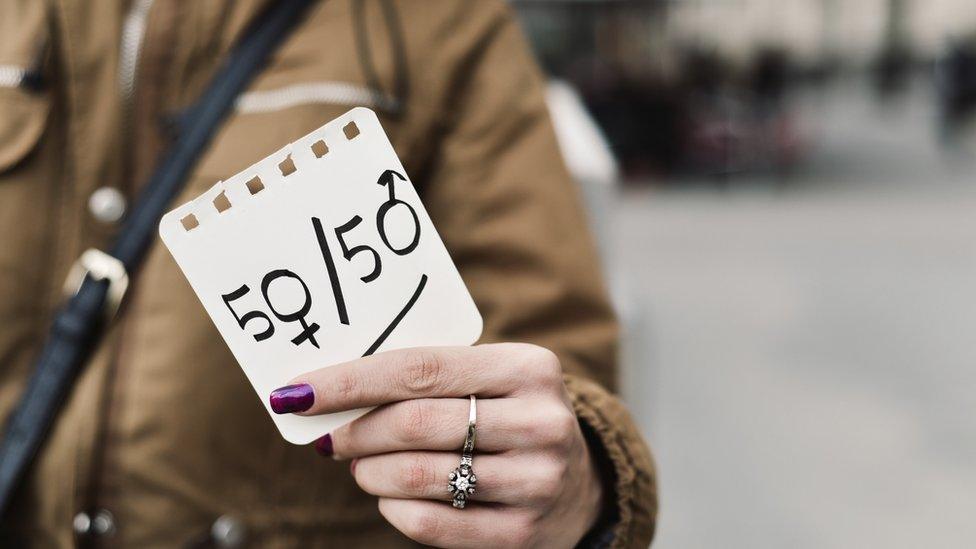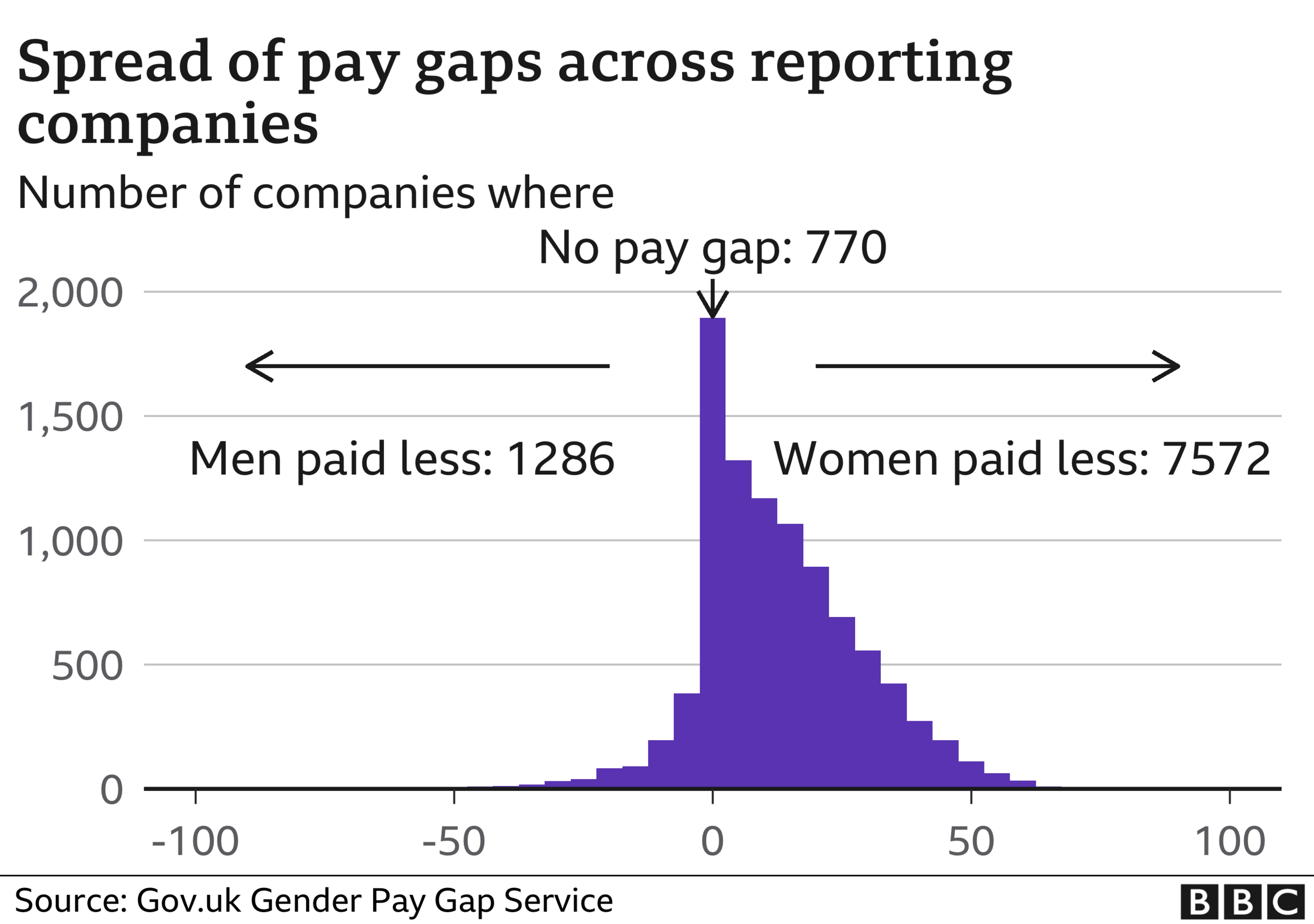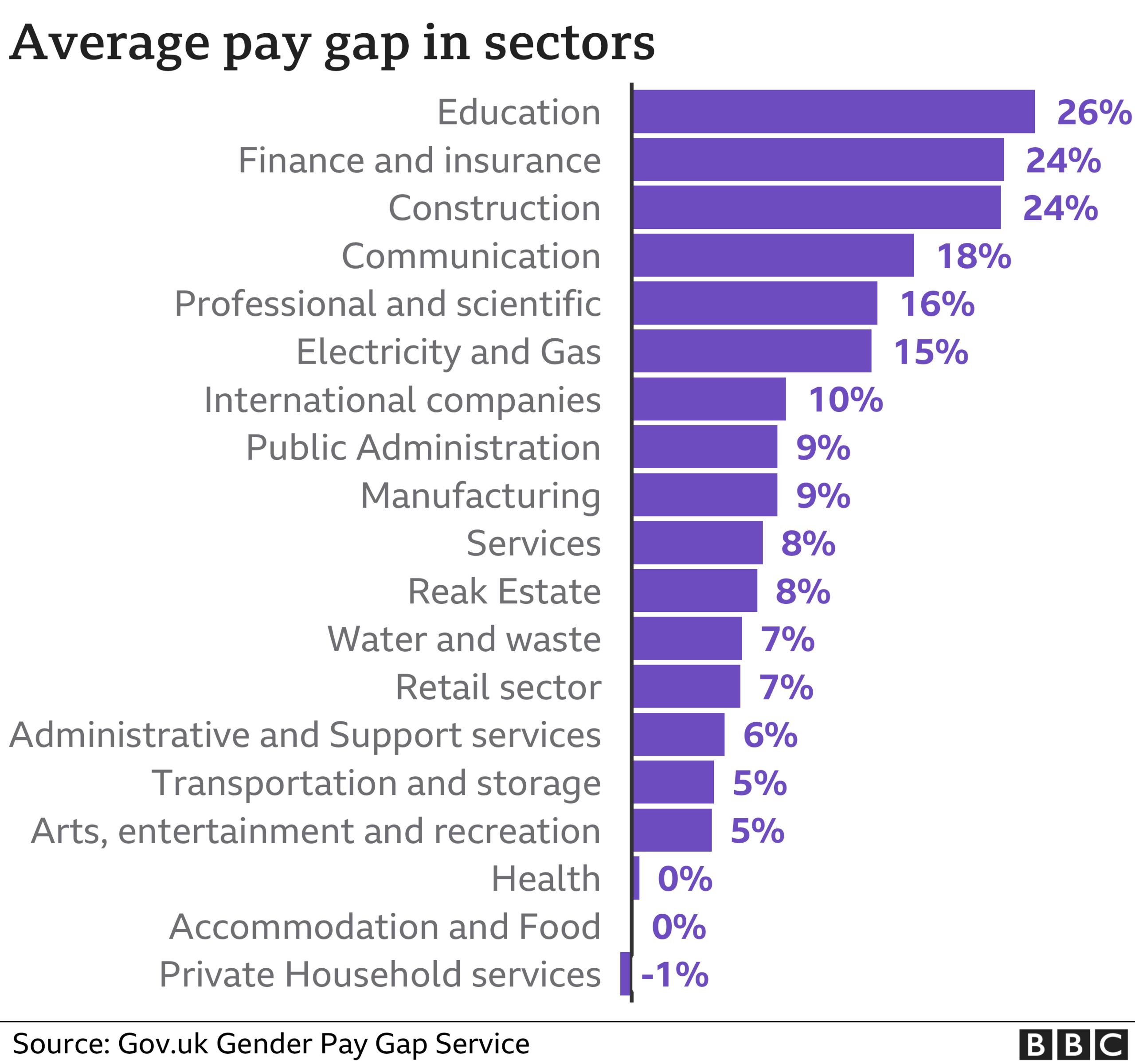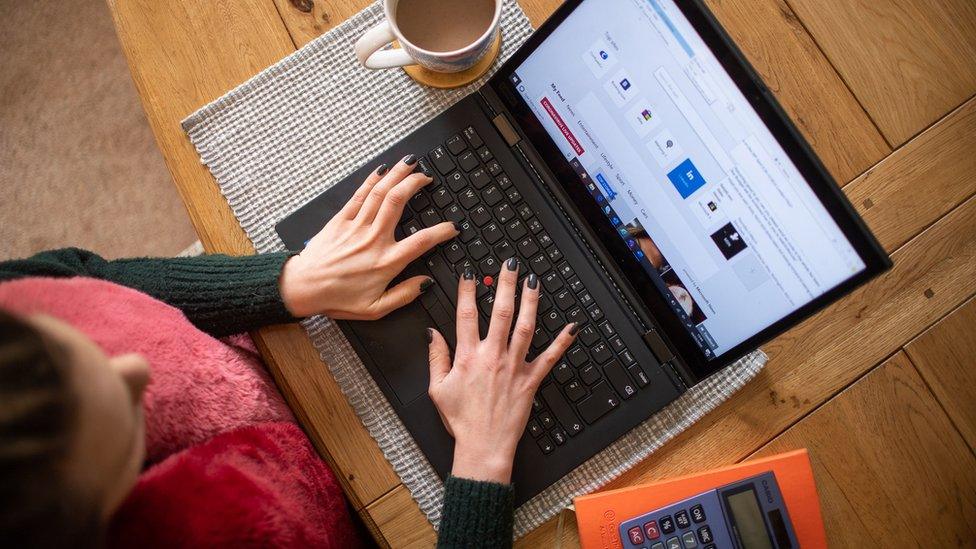Pay gap between men and women fails to improve
- Published

The average gender pay gap of all firms that reported in the past financial year is 10.4% - the same as the average of all firms reporting in 2019-20.
The BBC looked at a company's median pay gap - that is, the difference in pay between the middle-ranking woman and the middle-ranking man.
This is different to unequal pay - paying women less than men for the same work - which is illegal.
In all, 9,628 companies reported in time for the deadline.
That was up from a total number of 6,945 firms that reported in 2019.
Of the companies that had reported by the deadline of 5 October:
7,572 report a pay gap which favours men
1,286 have a pay gap favouring women
770 report no pay gap.

Of businesses with more than 20,000 employees, some with the biggest increase in the pay gap towards men compared with last year include Wetherspoon's, Argos, Sky, Amazon and HSBC.

Conversely, Jaguar, Sky and Travis Perkins were amongst those to report the biggest change in favour of women.

The median pay gap is not the same as paying women less than men to do the same work, which is illegal in the UK. But using the median pay measure is helpful in understanding the number of women in companies who hold senior roles.
The BBC's analysis found that by sector, the worst gender pay gaps on average are in education (26%), finance and insurance (24%) and construction (23.8%).

The private household services sector had the smallest average gender pay gap at 0.75%, closely followed by accommodation and food (0.1%) and health (0.5%).
A spokesperson from the government said that gender pay gap reporting had "helped to focus and motivate employers to tackle inequality in their workforce".
"Given the circumstances of the last 18 months, the EHRC was right to suspend enforcement action and we are pleased that so many organisations have submitted their reports on time," the spokesperson added.

By law, companies, charities and public sector departments of 250 employees or more must publish their gender pay gap figures on the Gender Pay Gap Service website. , external

Non-binary pay
The government regulations require employers to calculate their gender pay gap by comparing the pay of their male and female employees. However, these regulations do not address how employers should make their gender pay gap calculation if they have non-binary employees who do not identify as either male or female.
Furlough has also affected the data. While Wetherspoon's gap gap appears to have soared by more than 22 percentage points, more than 40,000 of their staff were furloughed and so were not included on the snapshot date of 5 April 2020, when the data was collected. A spokesperson from the company said there were only 52 employees in relevant employment on the snapshot date.
In order to provide a comparison with previous years, Wetherspoon's said the same calculations were made based on the 42,820 employees who, before the Covid lockdown on 20 March 2020, were working in their UK pubs, hotels and head office. The median pay gap, "taking account of all employees, was 0.45% , meaning, on average, women earned more than men", the spokesperson added.
The BBC's analysis shows that banks continue to dominate the top 10 companies with the highest pay gap in favour of men. Lloyds Bank, National Westminster Bank, Barclays Execution Services and HSBC each claimed a place in the top 10.
'Alarming' large pay gaps
Rosie Campbell, professor of politics at King's College London and director of the Global Institute for Women's Leadership, explained that although furlough was a caveat to the figures, she thought it was "alarming" that so many national employers and High Street names continued to have "such large pay gaps".
"Tackling the gender pay gap in the wake of a crisis that has had a disproportionate impact on the financial security of women is more important than ever," she added.
Covid has had a disproportionate impact on women, external, who have been more likely to lose work and earnings during the pandemic.
"We'd like to see the government take the initiative by strengthening our gender pay gap reporting legislation to make it a tool for action not just measurement, by including employers with more than 50 staff and by introducing mandatory action plans," Prof Campbell added.
'Decades of glacial change'
Dr Grace Lordan, founder of The Inclusion Initiative at the London School of Economics, agreed that greater granularity in the reporting would lead to more accurate insights.
"Focusing on the median obscures the fact that men are majorly over represented in the highest paying decision making roles," she said.
"By emphasising the median, it's like we are saying that as a society, we want women to be equal to men only up to a certain point in the hierarchy, and even if they get to top positions, it is OK that they are paid less than men," Dr Lordan continued.
"It's been decades of glacial change on the gender pay gap and 2021 reporting is no different. This is not going to get any better without a shift within companies towards inclusive leaders who understand the value of including women in opportunities."

Understanding the terminology
Median pay gap
The median pay gap is the difference in pay between the middle-ranking woman and the middle-ranking man.
If you place all the men and women working at a company into two lines in order of salary, the median pay gap will be the difference in salary between the woman in the middle of her line and the man in the middle of his.
Mean pay gap
The mean pay gap is the difference between a company's total wage spend per woman and its total spend per man.
The number is calculated by taking the total wage bill for each and dividing it by the number of men and women employed by the organisation.
Pay gap v equal pay
The gender pay gap is not the same as unequal pay.
Unequal pay is giving women less than men for the same work. That has been against the law since the Equal Pay Act was introduced in 1970.
A company's gender pay gap can also be caused by other things, for example fewer women in senior or highly-paid roles or more women in part-time jobs.
This analysis is based on the difference in what men and women are paid per hour, but there are other ways of calculating the gender pay gap: the Office for National Statistics also releases annual figures, external.


Some may be tempted to dismiss the requirement for big employers to report gender pay gaps as red tape or even virtue-signalling.
But it's been a useful, if rather blunt, tool in highlighting and supporting the progression of women, showing where work is needed and where strides are being made. With the current challenge of finding enough skilled workers to keep the economy moving, making the most of the talent we have is vital.
However, this time, the process has been clogged up by the pandemic. The delay in reporting means these particular numbers refer to the distant days of spring 2020, and workers who were furloughed may not be included, making it hard to track how some companies have improved - or not. In time, that distortion will disappear.
In the meantime, there will be a more up-to-date picture of gender pay across the country, with an alternative survey of organisations of all sizes from the official statistics body, the ONS, later this month. That had previously shown the gap narrowing.
The UK was a pioneer in reporting gender pay, but some say the policy lacks teeth without concrete action plans. They urge businesses and policy makers to overhaul areas including childcare and organisational culture as they seek to "build back better", to make emphatic progress and avoid this being an annual box-ticking exercise.
Related topics
- Published23 February 2021

- Published10 September 2021
